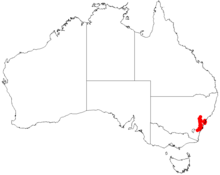| Darwinia taxifolia | |
|---|---|

| |
| Darwinia taxifolia subsp. macrolaena in the Royal Botanic Gardens, Cranbourne | |
| Scientific classification | |
| Kingdom: | Plantae |
| Clade: | Tracheophytes |
| Clade: | Angiosperms |
| Clade: | Eudicots |
| Clade: | Rosids |
| Order: | Myrtales |
| Family: | Myrtaceae |
| Genus: | Darwinia |
| Species: | D. taxifolia |
| Binomial name | |
| Darwinia taxifolia A.Cunn. | |

| |
| Occurrence data from AVH | |
| Synonyms | |
| |
Darwinia taxifolia is a species of flowering plant in the myrtle family Myrtaceae and is endemic to New South Wales. It is an erect or low-lying shrub with laterally compressed leaves. The flowers are pink or purplish and usually arranged in groups of two to four.
Description
Darwinia taxifolia is an erect or low-lying shrub that typically grows to a height of up to 1 m (3 ft 3 in). Its leaves are 5–12 mm (0.20–0.47 in) long and laterally compressed so that they are thicker than wide. The flowers are arranged in clusters of 2 to 4, rarely up to 6, the clusters on a peduncle about 1 mm (0.039 in) long surrounded by rough, leaf-like bracts and pink or purplish bracteoles 3–8 mm (0.12–0.31 in) long. The floral tube is 5–9 mm (0.20–0.35 in) long and 1–2 mm (0.039–0.079 in) wide, and the style is red. Flowering occurs from September to December.
Taxonomy
Darwinia taxifolia was first formally described in 1825 by Allan Cunningham in Geographical Memoirs on New South Wales, based on plant material collected from rocky areas of the Blue Mountains. The specific epithet (taxifolia) means "yew tree-leaved".
In 1962, Barbara G. Briggs described three subspecies in Contributions from the New South Wales National Herbarium, and the names of two are accepted by the Australian Plant Census:
- Darwinia taxifolia subsp. macrolaena B.G.Briggs has bracteoles 7–14 mm (0.28–0.55 in) long and a style 15–24 mm (0.59–0.94 in) long.
- Darwinia taxifolia A.Cunn. subsp.taxifolia has bracteoles 5–8 mm (0.20–0.31 in) long and a style 6–12 mm (0.24–0.47 in) long.
Distribution and habitat
Subspecies macrolaena grows in heath and is found from the Blue Mountains to Nerriga and Tomerong in south-eastern New South Wales, and subspecies taxifolia is restricted to heath on elevated sites in the Blue Mountains.
References
- ^ "Darwinia taxifolia". Australian Plant Census. Retrieved 23 December 2022.
- Wilson, Peter G. "Darwinia taxifolia". Royal Botanic Garden Sydney. Retrieved 23 December 2022.
- "Darwinia taxifolia". APNI. Retrieved 23 December 2022.
- Cunningham, Allan (1825). Field, Barron (ed.). Geographical Memoirs on New South Wales. London: John Murray. p. 352. Retrieved 23 December 2022.
- Sharr, Francis Aubi; George, Alex (2019). Western Australian Plant Names and Their Meanings (3rd ed.). Kardinya, WA: Four Gables Press. p. 320. ISBN 9780958034180.
- "Darwinia taxifolia subsp. macrolaena". Australian Plant Census. Retrieved 23 December 2022.
- ^ Wilson, Peter G. "Darwinia taxifolia subsp. macrolaena". Royal Botanic Garden Sydney. Retrieved 23 December 2022.
- "Darwinia taxifolia subsp.taxifolia". Australian Plant Census. Retrieved 23 December 2022.
- ^ Wilson, Peter G. "Darwinia taxifolia subsp.taxifolia". Royal Botanic Garden Sydney. Retrieved 23 December 2022.
| Taxon identifiers | |
|---|---|
| Darwinia taxifolia |
|
| Darwinia taxifolia subsp. macrolaena | |
| Darwinia taxifolia subsp. taxifolia | |